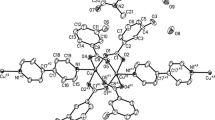Abstract
A redox reaction that occurs in the [Cu2B10H10]/Phen system in CH3CN/DMSO and CH3CN/DMF in air yields a Cu(II) binuclear complex, [(Phen)2Cu(CO3)Cu(Phen)2]2+. The [Cu2(Phen)4(μ-CO3)]B10H10 · 2.5DMSO · 2H2O (I) and [Cu2(Phen)4(μ-CO3)]B10H10 · 4DMF (II) compounds have been isolated and studied by X-ray crystallography at 150 K and EPR at 295 K. Their magnetic properties have been studied in the range 300–2 K. In the cations of both compounds, the bridging CO 2−3 group is bidentately coordinated to two Cu atoms. The cations in I and II have different spatial orientations of the Cu-O bonds: anti-syn and anti-anti, respectively. Compound I has weak magnetic interactions caused by a short Cu…Cu distance (4.441 Å) in the dimer. No exchange coupling is observed in II.
Similar content being viewed by others
References
V. V. Avdeeva, A. E. Dziova, E. A. Malinina, et al., Dokl. Chem. 437, 79 (2011).
V. V. Avdeeva, A. E. Dziova, I. N. Polyakova, et al., Russ. J. Inorg. Chem. 58, 657 (2013).
A. E. Dziova, V. V. Avdeeva, I. N. Polyakova, et al., Dokl. Chem. 442, 1 (2012).
E. A. Malinina, L. V. Goeva, K. A. Solntsev, and N. T. Kuznetsov, Zh. Neorg. Khim. 38, 38 (1993).
H. C. Miller, N. E. Miller, and E. L. Muetterties, J. Am. Chem. Soc. 85, 3885 (1963).
L. I. Ochertyanova, V. N. Mustyatsa, O. N. Belousova, et al., Inorg. Mater. 40, 144 (2004).
Yu. V. Rakitin, G. M. Larin, and V. V. Minin, Interpretation of EPR Spectra of Coordination Compounds (Nauka, Moscow, 1993) [in Russian].
APEX2 (Version 2008.6-1), SAINT (Version 7.60A), SADABS (Version 2008/1), Bruker AXS, Inc., Madison Wisconsin, USA, 2008–2009.
G. M. Sheldrick, Acta Crystallogr. A 64, 112 (2008).
Z. W. Mao, F. W. Heinemann, G. Liehr, and R. V. Eldik, J. Chem. Soc., Dalton Trans., 3652 (2001).
Ya. S. Lebedev and V. I. Muromtsev, EPR and Relaxation of Stabilized Radicals (Khimiya, Moscow, 1972) [in Russian].
R. Wilson and D. Kivelson, J. Chem. Phys. 44, 154 (1966).
Author information
Authors and Affiliations
Additional information
Original Russian Text © A.E. Dziova, V.V. Avdeeva, I.N. Polyakova, E.A. Malinina, A.V. Rotov, N.N. Efimov, E.A. Ugolkova, V.V. Minin, N.T. Kuznetsov, 2014, published in Zhurnal Neorganicheskoi Khimii, 2014, Vol. 59, No. 1, pp. 51–59.
Rights and permissions
About this article
Cite this article
Dziova, A.E., Avdeeva, V.V., Polyakova, I.N. et al. anti-syn and anti-anti coordination of the bridging CO 2−3 group in [Cu2(Phen)4(μ-CO3)]B10H10 binuclear complexes: Synthesis, structure, and magnetic properties. Russ. J. Inorg. Chem. 58, 1527–1535 (2013). https://doi.org/10.1134/S0036023614010045
Received:
Published:
Issue Date:
DOI: https://doi.org/10.1134/S0036023614010045



